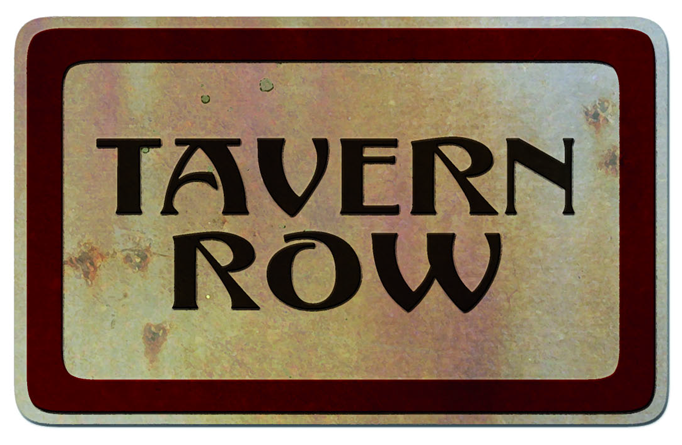 IN THE SHADOW OF THE SPIRE
IN THE SHADOW OF THE SPIRE
SESSION 38B: NASIRA’S STORY
June 7th, 2009
The 21st Day of Kadal in the 790th Year of the Seyrunian Dynasty

THE END OF THE TAVERN ROW WAR
They returned to the Ghostly Minstrel, wondering if their scheme had successfully confounded Silion and her minions. (Or if, in fact, it had been necessary at all: They had seen no signs of pursuit.) Approaching the inn they saw, much to Tee’s delight, that Daersidian’s dragon mount was tethered outside. Inside, the Minstrel was humming with activity: Cardalian, eating a meal in one corner, gave them a friendly wave as they came through the door, and she was only one among more than a dozen familiar and unfamiliar faces.
Tee took her meal to a table near the windows where she could look out on the dragon (sending herself into peels of bliss when it looked in at her), but Elestra and Agnarr chose to join Daersidian himself where he was sitting with his friend Brusselt, Jevicca, and Steron Vsool. They chatted casually about nothing of much import, until Agnarr — uncharacteristically finding himself abashed — built up the courage to ask Jevicca to train Seeaeti with him.
Jevicca smiled and laughed. “You have a dog?”
“A fine and noble hound!”
Jevicca politely declined, but agreed that they should find some time to spend together soon.
Ranthir, meanwhile, found himself distracted by a heavily tattooed man who was drinking at the bar. The man was only half-clothed, allowing Ranthir to observe a great many of the intricate tattoos, which he recognized as being of an arcane and particularly esoteric quality. He eventually built up the nerve to approach the man.
“Um… excuse me?”
“Yes?” the man asked with a nasty edge in his voice. “What do you want?”
“I was curious about your rather remarkable tattoos.”
“What about them?”
“What do… what do they do?”
At the first the man seemed suspicious and even a little hostile, but after Ranthir offered to buy him a drink (the first of many) he lightened up considerably. He gave his name as Araki and explained that the tattoos were “living scroll magic”.
“They’ve been bonded to my skin, but I can use them like scrolls.”
“Only once?”
 “It depends upon the quality – the deliblility – of the ink,” Araki explained.
“It depends upon the quality – the deliblility – of the ink,” Araki explained.
“I would like to learn how to do that myself.”
“I’m not much of a teacher, young one.”
Tor, for his part, had spotted Sister Mara from the Imperial Church sitting at a table in the corner with a half dozen others. He headed in their direction and asked if he might join their table. Mara agreed, introducing the others as members of the Runewardens – a company of delvers that she had once belonged to before her duties with the Church had expanded. Tor got the distinct feeling that speaking of the Banewarrens in front of the Runewardens would be a bad idea, but he settled in for a few friendly drinks and listened to their tales of adventure.
About an hour after they had all settled into the comfortable affability of the common room, a man came bursting through the front door of the inn, gasping for breath. While Tellith was still trying to calm him down enough to speak, he was joined by two others, all bearing the same news: Tavern Row was in pandemonium.
More than a dozen Killravens, including some powerful arcanists, had descended on the Onyx Spider – a tavern well-known to be in the pocket of the Balacazars. The Balacazars, however, must have been waiting for them: A massive melee had broken out in the tavern’s common room. There were even reports that Malkeen Balacazar himself had been there. (When Elestra asked around a little later, she heard reports of a “man with a black maw” – which sounded terrifyingly like the void-mouthed man who had menaced them in the caverns below the Cliffs of Lost Wishes).
Apparently the Killravens had eventually been routed, but only after causing massive damage to the Onyx Spider. Now rumors were swirling that this was only the first strike in a massive gang war. People were worried that the entire city was going to be consumed in violence.
Tee and Elestra excused themselves and headed in the direction of the Onyx Spider. By the time they got there it was clear that the most recent rumors were greater than the reality: The attack had been severe and Tavern Row was filled with members of the city watch, but it was clear that there was no danger of additional violence here.
Peeking inside the Onyx Spider itself, they saw that the great crystal sphere containing a spider of black onyx had been cracked. Asking around they discovered that fifteen minutes before the attack, the watchmen who had been standing guard along the Row had suddenly disappeared. Tee suspected bribery, and that was certainly one of the stories going around. Another, and perhaps more worrisome one, was that the guards had been ordered off by the Commissar. Tee knew that the Commissar countenanced the Balacazars in an effort to avoid exactly this sort of open warfare in the streets, but she hated to think of him as being that far in their pocket.
While Elestra returned to the Ghostly Minstrel, Tee decided to take her thoughts and make a late night of it. She spent the next several hours trying to track down more information on the enigmatic Silion… but, in the end, she didn’t manage to turn anything up.
Tor, meanwhile, had also left the Minstrel. He wanted to reach the Siege Tower before the sun set so that he could see how the Necropolis was sealed at night. It was little more than an idle curiousity, however, and after watching the massive gates of the Siege Tower swing shut (which happened as the last rays of the sun faded from behind the Spire) he spoke with one of the Knights of the Veil about whether they might know anything about the location of Alchestrin’s Tomb.
The knight shook his head. “We are protectors of the Necropolis, not record-keepers. But if any of us might know, it would be the loremaster Sir Seppa.”
Tor waited while Sir Seppa was sought out, and found him to be an affable man of middle years. Seppa was unfamiliar with Alchestrin’s Tomb, but he was quite familiar with the pertinent records at the Administration Building and – if any record of its location was to be had – he was certain he could find it.
Tor was happy to hear it. He made arrangements to meet with Seppa at the Administration Building the next day.
A DRESS OF PALE BROWN
The next morning, as was her familiar custom, Tee arose a few hours before the others and went down to the common room to break her fast. While she picked at pieces of cold mutton, a young woman approached her table. She was a wiry thing — rather plain, and generally brown: tanned skin, light brown eyes, brown hair, and with a dress of pale brown.
“Is your name Tithenmamiwen?”
Tee nodded.
“My name is Nasira. I’ve been told that you were asking questions about a woman named Silion.”
Tee palmed a dagger.
CHARACTER BACKGROUND: NASIRA
Nasira is a young woman. A little taller than average, she’s also wiry thin, rather plain, and generally brown – tanned skin, light brown eyes, brown hair, and often dressed in simple clothing of brown or tan. Quite monochromatic. Around the eyes she has that particular look of worn determination that those who have gazed into the long, hard face of nature often have.
NASIRA’S YOUTH
It is said that the Southern Desert creeps further north with every passing moon. In some of the sandtales of the south it is said that one day Old Satha, the shadow of the desert, will leap where once she crept and then she’ll swallow up all the green lands and the sands shall blow from dune to dune unto the Furthest North and Old Satha will find Frissa Icewhiskers, the Love She Never Knew.
Those are just tales. But if there’s any truth to the histories which say that once the Arathian plains swept far south into what is now naught but desert, then the valley of Jathera stands as a testament to it. Nearly a hundred miles further south than the nearest Arathian settlement to the north, the long, crevassed valley of Jathera is an emerald treasure in the midst of barren dunes. Jathera’s fertile fields support a small village of a few hundred, with enough excess to send along in the seasonal trade caravans which also carry the ore from the silver mine north to the city-state of Tepal.
Nasira was born in Jathera. She was thought a serious and quiet child. She may have even been considered a bit odd, the way that she would keep sneaking out into the desert. Perhaps her father, Aaftab, should have taken her a bit more in hand, but with her mother gone (stolen by the fever when she was small – a woman she only had a few fragmentary memories of now)… well, they got along well and she was healthy and reasonably happy, so he kept her with him and let her do as she would.
Many years before she was born, Nasira’s grandfather had found – by chance – a life-size statue of solid mithril in the desert sands south of Jathera. The discovery had made him a wealthy man. He could have lived like a king for a year, but instead he bought one of the largest plantations in the valley and settled down.
Nasira’s grandfather had made a point of making a yearly pilgrimage into the desert, to offer proper thanks to the gods who had blessed him with his prosperity. Nasira’s father, perhaps inspired by these yearly pilgrimages, became fascinated by the ruins throughout the region.
These ruins were often covered by sand, but Nasira’s father had been born into wealth. And although he worked hard on the farm during the months of the harvest, the wealth gave him the freedom to spend large portions of the rest of the year wandering the desert sands and seeking out whatever ruins had been surfaced by the winds of the summer and the winter. He became known to the people of Jathera as “the Little Treasure Hunter”, a name he kept even after he had grown large with years.
Nasira spent little time in the village school, instead spending much of her youth with her father on his expeditions. There she met the Atapi for the first time – small bands of nomads who wandered the desert sands. The Jatherans were not welcoming of the Atapi and generally the reverse was true as well, but they accepted Nasira and her father. And while her father’s attentions were focused on ruins and artifacts, Nasira spent more and more time learning to ride and find water; sharing the stories of the Atapi when they were near and trying to befriend lizards and little desert mice when they weren’t.
COMING OF AGE IN TEPAL
When Nasira was twelve, her aunt Salla came to visit the family in Jathera. While Nasira’s father had used the inheritance to follow in his father’s footsteps, Salla had taken her share of the inheritance and moved to the city-state of Tepal. Salla was distressed by Nasira’s lackadaisical upbringing and “uncivilized” behavior. She eventually convinced Nasira’s father that it would be best if Nasira came back with her to Tepal to “continue the proper education for a young woman”.
Tepal, as the southernmost of the Arathian city-states, is often seen as the very edge of civilization. In fact, the trade route running between Tepal in the east and Nathia in the west is often drawn as the official border of both Arathia and the Five Empires (although several villages, like Jathera, are located further south).
Tepal is also one of the three coastal city-states in Arathia. Like Casalia and Ptolus, it’s perched atop the Arathian Cliffs and possesses no natural ports. Unlike those other cities, however, its coastal waters are wracked with reefs and functionally unnavigable by larger vessels. As a result, no artificial ports (like the docks in Ptolus or the sea cranes of Casalia) were ever constructed. However, several paths leading through the sandstone caverns beneath the city make it possible for the city-state’s fishing fleet to sail out into the Southern Sea and return.
In short, Tepal may be the poorest and perhaps smallest of the Arathian city-states. But for Nasira, it was wealthy and large almost beyond imagination.
THE CHURCH OF THE TWIN SISTERS
At this time, a religious fervor was gripping Tepal in the form of the Reformist Church of the Twin Sisters. What had begun as a populist wave of mass conversion had reached through the Trade Circle and into the Circle of Princes. Salla had been an early convert of the church, and she was able to use her connections to get Nasira enrolled in the tutelage program at the Temple of the Sun and the Sea.
The Temple of the Sun and the Sea was built on (and over) the edge of the Arathian Cliffs. The Lower Temple of the Sea was crafted from ocean sandstone, its beautiful blue swells welcoming the ocean waves into the artificial tidal pool maintained in its sanctuary.
Ocean sandstone is a rare, beautiful, and expensive stone quarried from the sea floor itself. The stone is a pale blue in color, with delicate bands of darker color running through it in soft, undulating curves. Alchemists claim that the stone is the result of an “elemental infusion” – the stone’s proximity to water literally grants it some affinity to the water’s elemental properties. When viewed through water, ocean sandstone seems to flow before the eyes with the movement of the water itself. This effect is particularly pronounced beneath dim lights.
The Upper Temple of the Sun was built on the edge of the cliffs within Tepal itself. In a massive, magically-assisted construction, the two temples were connected by the beautiful, fluted Stair of a Thousand Penances. Echoing the stairs below, a fluted crystalline spire extended from the top of the temple to catch Sayl’s Light at First Dawning.
Nasira spent the next several years in the temple. She did fairly well in its tutelage, being quiet and studious and therefore seen as obedient, which is better than being brilliant. But she was never very happy there. She liked the quiet, contemplative aspects of the training – the prayer times and the music lessons – but she missed her father and the desert and she found the other girls to be noisy and shallow (although she might have liked them better if they hadn’t spent quite so much time teasing her about being “plain as a sparrow and twice as dull”).
THE TENETS OF THE CHURCH
As they came of age, most of the girls left to get married or return to their former lives. But Nasira had no desire to do either and decided to stay and become a cleric. She was encouraged in this by Sister Tarathara, who had taken a liking to her and offered to become a mentor.
The Twin Sisters: The church worshipped Sarathyn (the Virgin Goddess of the Sea) and Sayl (Sun Goddess of Life and Sexuality). Its teachings were rooted in the dualities personified by the goddesses.
The Divine Daughters: The hierarchy of the Church of the Twin Sisters, known as the Divine Daughters, was matriarchal, reflecting the church’s teaching that the heart of humanity lies in feminine love.
The Duality of Love: Feminine love, in turn, is expressed through the twin dualities of the Sisters: Chastity as personified in the cold depths of Sarathyn’s sea; sexuality as felt in the hot rays of Sayl’s passion.
The Chain of Wombs: The tension within the duality of love is the imbalance from which all sentient life is given birth; the tension is embodied in the woman’s womb; and all life is connected through a great “chain of wombs”. The chain of wombs, of course, can be expressed genealogically through the matrilineal line, and the church believes that the patterns of life can be horoscopically cast through an analysis of the chain. (However, this is not merely a hereditary analysis; the harmonics of the chain exceed the merely familial and are affected by the patterns of your friends and associates).
The Wolf and the Dolphin: Just as the tension of the duality of love becomes the wellspring of the womb, so the tension held in the “goddess chain” is the source of civilization and society. The knitted weave of the chain is seen to pass through shadow and light. Within the shadow it is the hunger of the wolf (the patron animal of Sayl); and in the light it possesses the scintillant grace of the dolphin (the patron animal of Sarathyn).
RETURN TO JATHERA
In 785 YD, Sister Tarathara came to Nasira. Tarathara had been selected as one of the church’s preachers, to go forth and spread the church’s teachings beyond the walls of Tepal. She was to build a chapel in Jathera and she wanted Nasira, as a native of the place, to come with her.
Later that year, Nasira returned to Jathera.
The teachings of the Church of the Twin Sisters were met with some resistance (and occasionally outright hostility) from the people of Jathera (who, in their isolation, had remained almost universally stout followers of the Imperial Church).
Despite this, these were happy years for Nasira. She had not seen her father in years, and now she was often able to journey with him back into her beloved desert and renew her friendship with the Atapi. Time passed in peaceful, hard, and satisfying work.
THE FALL OF JATHERA
In 788 YD, a traveling scholar came to Jathera. His name was Wuntad. Sister Tarathara allowed him to room in the chapel, and it quickly became clear to Nasira that the two of them shared an old friendship. Often they would be up late into the night talking over Wuntad’s dusty parchments and tomes.
Nasira paid it little mind. What did it matter to her that Tarathara had an old friend to talk with? She had many. And, besides, she was busy with other affairs.
However, when Wuntad learned that Nasira’s father had spent years studying the Atapi he asked Nasira to instroduce them. Apparently it was lore of the Atapi that had brought him to Jathera, and he was eager to meet another loremaster of a similar bent.
At first Nasira’s father shared Wuntad’s enthusiasm. But over time he began to view Wuntad’s… fervor with deeper and deeper suspicion. He spoke to Nasira about his concerns, but she thought little of them. If her father didn’t want to work with Wuntad, then he should simply stop speaking with him, no matter how insistent he might become.
Nasira was also distracted by other concerns: She had decided to share her faith with the Atapi and was now working diligently to teach them the Words of the Twin Sisters. For the most part, the Atapi met her efforts with bemusement, but she was often travelling into the desert with supplies and fresh teachings.
In Taranal 789 YD, however, Nasira saw Jathera for the last time. She journeyed into the desert… and when she returned her life was changed forever.
During her absence, a large group of outsiders had arrived in town. Wuntad had led them in an assault on her father’s villa. Many of the other villagers had rallied to her father’s aid, but this only served to turn Wuntad’s wrath upon a village as a whole. Dozens – including her father – had been slaughtered. But Wuntad’s wrath had not been sated by the slaughter: He destroyed the great crystalline sphere whose magic had long protected the valley. Already the verdant fields of her youth were wilting beneath the unforgiving rays of Sayl and the blowing sands of the desert were seeking to reclaim their own.
Worse yet, Nasira discovered that Tarathara had been complicit in the attack. She had aided Wuntad in his slaughter and left the village when it was complete.
THE LONG AND LONELY ROAD
Nasira’s faith in the Church was broken and she fled into the desert, trying to escape the guilt of surviving… and for not realizing that anything was wrong with her mentor or her strange friend.
For many months she stayed with the Atapi, thinking that she could lose herself in their way of life. But, in time, she realized that she was following a false path. Her faith in the Church may have been broken by Tarathara’s betrayal, but not her faith in her gods. And she also discovered the deep, burning desire to learn the truth of what had happened. Who was Wuntad? What was he trying to accomplish that was worth the blood he had shed?
She left the Atapi and returned to Tepal. She had no leads on Wuntad himself, but she began the long and arduous process of retracing Tarathara’s past.
What she discovered was terrifying: Both Wuntad and Tarathara belonged to chaos cultists dedicated to the Lords of Chaos and the sowing of destruction and anarchy. She eventually succeeded in tracking Tarathara to Ptolus, who she hoped would lead her in turn to Wuntad and her revenge…
Running the Campaign: Adding a New Player (Part 2) – Campaign Journal: Session 38C
In the Shadow of the Spire: Index



















